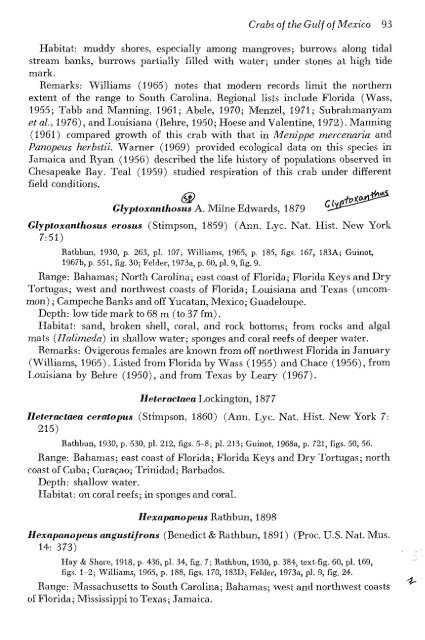You also want an ePaper? Increase the reach of your titles
YUMPU automatically turns print PDFs into web optimized ePapers that Google loves.
Crabs of the Gulf of Mexico 93<br />
Habitat: muddy shores, especially among mangroves; burrows along tidal<br />
stream banks, burrows partially filled with water; under stones at high tide<br />
mark.<br />
Remarks: Williams (1965) notes that modern records limit the northern<br />
extent of the range to South Carolina. Regional lists include Florida (Wass,<br />
1955; Tabb and Manning, 1961; Abele, 1970; Menzel, 1971; Subrahmanyam<br />
etai, 1976), and Louisiana (Behre, 1950; Hoese and Valentine, 1972). Manning<br />
(1961) compared growth of this crab with that in Menippe mercenaria and<br />
Panopeus herbstii. Warner (1969) provided ecological data on this species in<br />
Jamaica and Ryan (1956) described the life history of populations observed in<br />
Chesapeake Bay. Teal (1959) studied respiration of this crab under different<br />
field conditions.<br />
Glyploxanthosus A. Milne Edwards, 1879<br />
Glyploxanthosus erosus (Stimpson, 1859) (Ann. Lye. Nat. Hist. New York<br />
7:51)<br />
Rathbun, 1930, p. 263, pi. 107; Williams, 1965, p. 185, figs. 167, 183A; Guinot,<br />
1967b, p. 551, fig. 30; Felder, 1973a, p. 60, pi. 9, fig. 9.<br />
Range: Bahamas; North Carolina; east coast of Florida; Florida Keys and Dry<br />
Tortugas; west and northwest coasts of Florida; Louisiana and Texas (uncommon)<br />
; Campeche Banks and off Yucatan, Mexico; Guadeloupe.<br />
Depth: low tide mark to 68 m (to 37 fm).<br />
Habitat: sand, broken shell, coral, and rock bottoms; from rocks and algal<br />
mats {Halimeda) in shallow water; sponges and coral reefs of deeper water.<br />
Remarks: Ovigerous females are known from off northwest Florida in January<br />
(Williams, 1965). Listed from Florida by Wass (1955) and Chace (1956), from<br />
Louisiana by Behre (1950), and from Texas by Leary (1967).<br />
Heteraclaea Lockington, 1877<br />
Heleraclaea ceralopus (Stimpson, 1860) (Ann. Lye. Nat. Hist. New York 7:<br />
215)<br />
Rathbun, 1930, p. 530, pi. 212, figs. 5-8; pi. 213; Guinot, 1968a, p. 721, figs. 50, 56.<br />
Range: Bahamas; east coast of Florida; Florida Keys and Dry Tortugas; north<br />
coast of Cuba; Curagao; Trinidad; Barbados.<br />
Depth: shallow water.<br />
Habitat; on coral reefs; in sponges and coral.<br />
Hexapanopeus Rathbun,1898<br />
Hexapanopeus anguslifrons (Benedict & Rathbun, 1891) (Proc. U.S. Nat. Mus.<br />
14: 373)<br />
Hay & Shore, 1918, p. 436, pi. 34, fig. 7; Rathbun, 1930, p. 384, text-fig. 60, pi. 169,<br />
figs. 1-2; Williams, 1965, p. 188, figs. 170, 183D; Felder, 1973a, pi. 9, fig. 24.<br />
Range: Massachusetts to South Carolina; Bahamas; west and northwest coasts<br />
of Florida; Mississippi to Texas; Jamaica.<br />
^

















